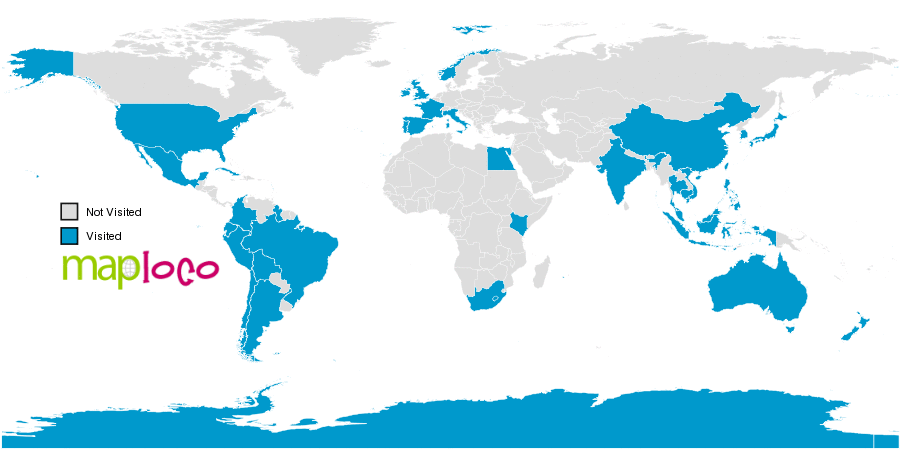Chiapas是墨西哥目前最多瑪雅後裔仍然聚居的地方,現在還有數十個土著村落。
今天,我們跟團參觀到了其中兩個村子,行程其實有點表面,導遊也是一般,不過加上我們的屋主提供的小故事,也就是一篇文章。
自從西班牙人佔領了中南美洲,他們做的其中一大改革就是全民天主教。我們到過的所有國家,都是由當時開始天主教傳入,到現在的人基本都是天主教徒。雖然當地人的教堂和歐洲看的會有點差異,有些還有挺濃厚的土著色彩,但大致還是天主教堂。
在Chamula的這個教堂就截然不同了。
外表看起來除了顏色有些特別,也沒其他,走進去就兩回事了。
教堂內沒有座位,沒有神父的祭台,沒有所有你在天主教堂會看到的元素…取以代之的,是另一番景象。
兩旁有約二十多個能放得下一個人大小的玻璃箱,每個裏面供奉了一個天主教聖人的像,比如San Pedro, San Miguel, San Sebastian之類,還包括有耶蘇和聖母。
每個聖人的像前面有個桌面,放滿鮮花和蠟燭。前方還有很大的空地。信徒們帶同很多物品前來祈禱。讓我描述一下看到的情況。
- 一般好像都是一家老少同在,坐在其中一位聖人前方的空地上
- 他們帶來各種不同顏色和大小的蠟燭(據說不同顏色代表不同的元素,如綠色代表大地之母),把它們從大至小一排排固定在地上,最小的蠟燭最靠近自己,然後一一點著
- 除了蠟燭,他們的祭品還包括可口可樂…也看到一些其他飲品,但主要還是可樂(天啊!)
- 他們還有活祭品,會帶來一隻雞,我們沒法看到最後,但據說把病驅到雞身上,然後會扭斷雞頸,然後扔掉,就把病痛驅走了
雖然他們進行的完全不是天主教儀式,可以供奉的卻是天主教的聖人…真是獨有的,我們真是從未見過!
每個教堂都會有一個瑪雅的祭司,祭司同是也是醫師,村民有病就來讓他看。他也是像中醫一樣會把脈,從脈像看出是什麼病。然後祭司會透過祈禱,一些祭祀的儀式和傳統草藥來治病。
除了祭司外,每個聖人都配有幾個mayadormo,這些人任期一年,任期內他們要負責這個聖人的香火,供奉鮮花蠟燭,打掃清理信徒祈禱後的廢物之類。不止沒有工資,他們每年要花上約兩萬美元的費用去供奉。可是,由於這更多是身份和地位,排隊的人足讓你等上好幾年,期間你就要開始儲蓄了…有些人做了不足一年就花光了錢,有公司會放帳給他們,日後分期攤還。
這裡的土著,早就把正統的天主教會趕走,這些教堂除了受洗禮外,沒有任何天主教儀式。
除了宗教,這些土著村落也有他們自己的法律和司法人員。比如說,遊客是不能在公眾地方和宗教場所拍攝,在這裡拍照要非常小心,否則不只是禮貌問題,一不小心是會被捕的! 我們的屋主就說曾經有個美國人自己到訪這些村落,到處拍照,結果被抓起來,關在像鐵籠一樣的監獄內整整一天才放了他,如惹上這種麻煩,真的隨時招致殺身之禍!
為什麼?因為他們還有執行死刑的。
屋主說,就兩年前,村落裏有人犯了姦殺,這當然是重罪了。結果那罪犯被判以死刑,在廣場上被活生生燒死!
土著們也是非常的重男輕女,老掉牙的故事就不說了。另外,受教育的小孩也很少,他們的教育就是男耕女織,在他們的社會裏根本沒有什麼專業人仕,讀書並不會帶來工作和收入…少數受教育的人,畢業後肯定都是離開家裡到城市找工作的。
團中有些外國旅客就對此感到難以接受,但這就是他們的社會價值觀,我們這些城市人也許根本不能理解。
P.S. 因為不能拍照,只能在外面買了兩張明信片,是教堂內的情況
By: Jo
Chiapas is the region where the most indigenous groups live in Mexico. They are descendants from the Mayas, and many villages still exist in Chiapas.
Today, we went on a tour to visit the villages. The tour was very average, so was the guide but with the stories that our hosts told, we can totally write a blog about it.
Since the Spanish conquered Central and South America, one of the biggest change they made is make Catholic the national religion. All the countries we visited here have the religion been introduced in the 16th century, and now almost everyone is Catholic. Although some of their churches are different from those in Europe and have a strong indigenous style, but they are still in principle catholic churches.
The cathedral in Chamula is completely different.
The outside has a special colour but other than that, it doesn't look much of a big deal. But it is a different story when you are inside.
In the cathedral, there are no seats, no altar, none of the elements you can see if a catholic church are found inside... replaced by something else.
Along two sides of the walls, there are around twenty glass box about the size of a man. There is a statue of one saint inside each box, e.g. San Pedro, San Miguel, San Sebastian, etc. it also has Jesus and Virgin Mary.
In front of each Saint, there is a table, full of flowers and candles and there is a big space in front. The believers bring a lot of things to pray. Let me describe what we saw.
- They usually come as a family, from grandparents to kids, and sit in front of one of the Saints.
- They bring many candles of different colours and size (each colour means something, eg. green represents mother Earth). They fix the candles on the floor in rows, from big to small, with the smallest closest to the people and light them all.
- They start praying. The prayers are also a combination of catholic and Maya.
- Apart from candles, their offerings also include Coca Cola... I see some other soft drinks but mainly it is coca cola (OMG!)
- They also have sacrifice, they bring a live chicken. We did not have a chance to see the whole thing but we understand they believe that the bad spirits or sickness will be transferred to the chicken and then they will kill the chicken by twisting its neck and throw it in trash. By doing that, the bad spirit of illness will be cleared.
Although the rituals that they practise are completely not catholic, the Saints that they worship are catholic saints... I guess that is unique, I have never seen something like that.
There is a shaman in charge, it is also the Maya doctor. The villagers will come and see him when they are sick. He also will check your pulse like what Chinese doctors do, and diagnose the disease. The shaman will cure the patient using one of all of prayers, rituals, traditional medicinal plants, etc.
Apart from the in charge shaman, each Saint in the charge also has a few mayadormos (not sure if I get this word correct), each will serve the Saint for one year. During this one year, they need to make sure they put lots of fresh flowers and candles and clean up the area for the Saint. They not only not get paid, they need to spend around USD 20,000 each year to worship the Saint. However, since this is an honor, people wait on the list for years to be a Mayadormo. You can save money during the time you wait. Some people run out of money during the one year and companies will give them credit and they pay later by installments.
The indigenous people here have driven the catholic church away for a long time. Apart from the baptism, they do not perform any catholic rituals.
Apart from region, they also have their own laws and their own officers. E.g. tourists are not allowed to take any pictures in public or religious venues. Tourists have to be very careful about taking pictures, or they may be arrested. Our host said there was an American who went there on his own and take pictures everywhere. He was arrested and put in jail, one which is a steel cage in open area, for one full day before he was released. If you get into trouble here, you can lose your live.
Why? because they still have death penalties here.
Our host told us that, about two years ago, someone in the village rape and kill a girl. Of course, that is a serious crime, he was sent for death penalty and was burnt to death in the public square!
In the indigenous community, man and woman are not equal, the same old stories that we heard many times... Apart from that, kids don't go to school. Their way of education started when kids are 4 or 5 but they only teach girls to weave and boys to farm. In their community, education does not give them any job opportunity or money because there is no professionals in their community. The rarely educated people will leave the villages and work outside in the cities.
In our tour, a few tourists found this very unacceptable, but this is what they value in the indigenous communities. As people who grow up by a different set of values, we will never understand.
P.S. Since I cannot take any pictures, we bought two postcards that shows what happen inside.
By: Jo
